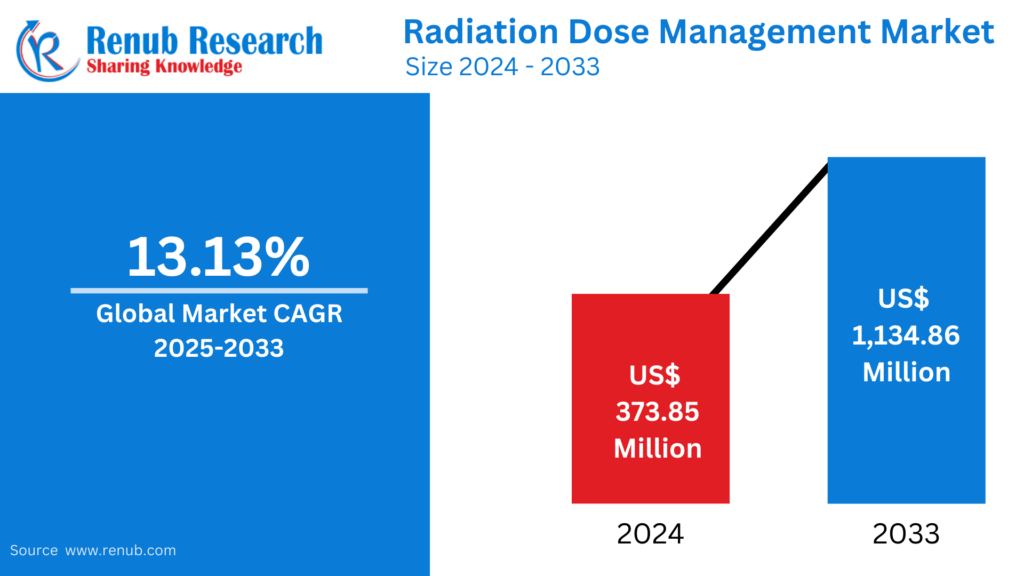Radiation Dose Management Market Size and Share Analysis – Growth Trends and Forecast Report 2025-2033
Market Overview
The Radiation Dose Management Market is projected to surge from US$ 373.85 million in 2024 to US$ 1,134.86 million by 2033, expanding at a CAGR of 13.13% during the forecast period 2025 to 2033. This growth is fueled by the increasing adoption of diagnostic imaging, the rise in chronic conditions like cancer, and the growing emphasis on patient safety through real-time monitoring and AI-integrated solutions.
Download Sample & Read More: https://www.renub.com/request-sample-page.php?gturl=radiation-dose-management-market-p.php
Understanding Radiation Dose Management
Radiation Dose Management (RDM) is a specialized medical system that manages, monitors, and optimizes radiation exposure levels in diagnostic imaging. It ensures safe imaging practices by maintaining a balance between image quality and radiation dosage. These systems are essential tools for healthcare professionals such as radiologists, medical physicists, and radiographers, as they provide:
- Real-time dosage tracking
- Historical data management
- Optimization of imaging protocols
- Regulatory compliance and reporting
RDM systems are predominantly used in hospitals, imaging centers, and research institutions to protect patients and staff from unnecessary radiation exposure.
Market Dynamics
Key Growth Drivers
- Rising Diagnostic Imaging Volume
With an increasing number of medical imaging procedures, particularly CT scans and fluoroscopy, RDM systems help manage high data volumes while enhancing patient safety.
- Technological Advancements
Advanced imaging technologies, such as AI-driven dose optimization tools and iterative reconstruction algorithms, allow accurate diagnostics with minimal exposure.
- Regulatory Guidelines Promoting Radiation Safety
Global health bodies like the IAEA, FDA, and EU have issued stringent guidelines to minimize radiation exposure. This regulatory push has accelerated the adoption of RDM solutions.
- Increasing Prevalence of Chronic Diseases
Chronic illnesses, especially cancers, require frequent imaging for diagnosis and monitoring. RDM ensures optimal dose usage, minimizing long-term radiation risks.
- Integration of AI and IoT
Modern systems integrated with AI and IoT provide predictive analytics, improve patient safety, and enable real-time dose tracking across connected devices.
Market Challenges
- High Implementation Costs
Installing RDM software and related infrastructure is expensive, particularly for small-scale hospitals or underdeveloped healthcare systems.
- Inadequate Infrastructure in Developing Nations
Countries in Africa, Asia, and Latin America often lack the technological infrastructure or funding required to adopt these advanced systems.
- Limited Training and Awareness
Many healthcare providers still lack proper knowledge and training in utilizing RDM tools, leading to underutilization and inefficiency.
Regional Insights
United States
With over 80 million CT scans conducted annually, the U.S. market is mature and technologically advanced. Regulatory pressure, aging demographics, and chronic illness prevalence continue to drive adoption.
Germany
Germany has witnessed rapid RDM adoption due to strong regulatory backing from the EU, robust hospital infrastructure, and the presence of leading R&D firms.
India
India’s rapidly growing medical sector and increasing awareness of radiation risks are driving growth. However, cost and training gaps remain key challenges.
United Arab Emirates
The UAE market benefits from modern healthcare infrastructure and strict compliance with global safety standards. Government investment and smart healthcare initiatives are expected to push the market forward.
Segmentation Analysis
By Product & Services
- Radiation Dose Management Solutions
- Radiation Dose Management Services
By Modality
- Computed Tomography (CT)
- Fluoroscopy & Interventional Imaging
- Mammography
- Nuclear Medicine
By End User
- Hospitals
- Ambulatory Care Settings
- Others
Country-Wise Market Coverage (23 Viewpoints)
- United States
- Canada
- Germany
- United Kingdom
- France
- Italy
- Netherlands
- Spain
- China
- South Korea
- Japan
- India
- Indonesia
- Malaysia
- Argentina
- Brazil
- Mexico
- Colombia
- Saudi Arabia
- South Africa
- Israel
- Australia
- UAE
Key Players and Company Analysis
The major companies operating in the Radiation Dose Management market are focusing on innovation, partnerships, and regulatory compliance to maintain competitiveness.
Companies Covered (from 4 Viewpoints):
- Bayer AG
- Koninklijke Philips N.V.
- Thermo Fisher Scientific Inc.
- McKesson Corporation
- Cerner Corporation
Viewpoints:
- Overview
- Key Executives
- Recent Developments & Strategies
- Financial Insights
Report Details
| Report Features | Details |
| Base Year | 2024 |
| Forecast Period | 2025 – 2033 |
| Historical Period | 2021 – 2024 |
| Market Value in 2024 | US$ 373.85 Million |
| Market Value Forecast 2033 | US$ 1,134.86 Million |
| CAGR (2025–2033) | 13.13% |
| Segments Covered | Product & Services, Modality, End User, Country |
| Geographic Coverage | 23 Countries |
| Companies Profiled | 5 Major Players |
Conclusion
The Radiation Dose Management Market is poised for remarkable growth, supported by technology innovations, expanding imaging procedures, and stringent regulatory frameworks. While cost and awareness remain challenges, the long-term outlook remains optimistic, with robust growth expected across developed and developing markets alike. As patient safety becomes a top priority, RDM systems will play a central role in transforming modern diagnostic imaging into a safer, smarter, and more compliant process.






